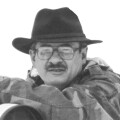News & Articles
Browse all content by date.
It has been for sometime a goal of mine to get the “grand slam” of North American bears (black, grizzly, polar and Alaskan brown) with a camera. I had numerous black bears in my photo stock that I had taken around northern Minnesota with some as close as my yard. In 1985 and 1989 I ventured by rail from Winnipeg to Churchill Manitoba, on Hudsons Bay’s southwest shore, to photograph polar bears as they congregate there in fall when their migration brings them to Cape Churchill to wait for freeze-up so they can venture out onto the ice for seals after a summer of fasting. Both trips gave me opportunities to photograph a total of seven bears.
In 2004 and 2005 I traveled to Alaska to photograph grizzly bears. On both trips I toured Denali Park and was able to see approximately 50 bears. The 2004 trip had grizzlies within 100 yards of my camera.
My third trip to Alaska, in 2006, had a goal of photographing Alaskan brown bears that are in the Lake Clark National Park located about 90 miles southwest of Soldotna, which is about 65 miles south of Anchorage. There I saw about 35 Alaskan browns with some as close as 40 yards. This location is about 70 miles from where the “grizzly man” and his significant other were killed by a bear brown.
When I know I will be photographing bears I carry a handgun that will do the job and/or pepper spray. I have been trained in the use of both. As a point of interest, pepper spray should be double bagged after being used and removed from the area along with you as it is a food source and can draw in other bears. If you do photograph bears, be courteous to them and safe by using telephoto lenses instead of getting close as these animals need their space.
I would never discourage anyone who attempts to do this type of photography, but realize there is a commitment needed to complete photography goals such as this. I will use the Alaskan brown bears as an example since it is the most recent. With the economy and fuel costs doing what they are doing, transportation is a big issue money-wise. If you plan to fly to Alaska, plan on $600.00 for round trip air fare from Minneapolis to Anchorage. After much research from home prior to the trip, I found a bear camp that hopefully would provide what I needed. That adds close to $800.00. One extra flight and two hotel nights in Anchorage adds $350.00 more. Goodies, souvenirs, etc. adds more.
Equipment used was two high-tech. digital camera bodies with anti-shake technology. This technology is nice as I often use very high-powered optics. A laptop computer eases image storage and frees up memory cards.
None of my bear photos were taken in winter; however they were taken in areas of unpredictable weather. This includes Minnesota. You need proper rain gear, layered clothing and sometimes a blind that not only acts as camouflage but shelter as well.
In over 99 percent of my bear experiences, I have not been in harms way BUT three times I felt threatened. First time was an encounter with a black bear. I was so close (caught off guard) that it took a swipe at me. I was legally hunting bear at the time and this bear ended up on my wall. The second time was up on Canada’s tundra. I was away from my getaway vehicle and was about 50 feet from a polar bear. I was observed doing this and subsequently asked if I was the “Crazy Yank” upon my return to town and was chewed out for taking such a chance, just for photographs. The third time was on the recent Alaskan trip when a guide needed to leave me alone to escort someone back to the bear camp. He left me a radio and did return in about 20 minutes. I did have bears get within 75 feet from me. I often wondered if the bear were to attack, would it have eaten me or the radio first. POINT BEING, you need to protect yourself.
This is no attempt to discourage anyone from doing this type of photography but it is my attempt to warn and advise everyone of the potential expenses and hazards related to such ventures. Is it worth it? You bet!
| Tweet |


